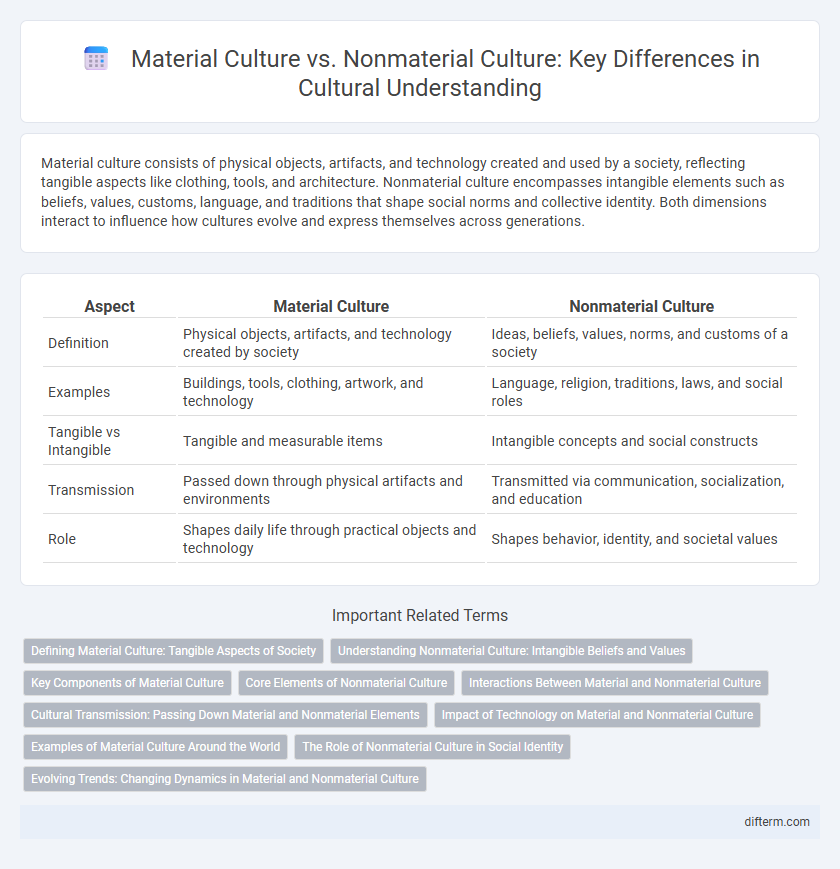Material culture consists of physical objects, artifacts, and technology created and used by a society, reflecting tangible aspects like clothing, tools, and architecture. Nonmaterial culture encompasses intangible elements such as beliefs, values, customs, language, and traditions that shape social norms and collective identity. Both dimensions interact to influence how cultures evolve and express themselves across generations.
Table of Comparison
| Aspect | Material Culture | Nonmaterial Culture |
|---|---|---|
| Definition | Physical objects, artifacts, and technology created by society | Ideas, beliefs, values, norms, and customs of a society |
| Examples | Buildings, tools, clothing, artwork, and technology | Language, religion, traditions, laws, and social roles |
| Tangible vs Intangible | Tangible and measurable items | Intangible concepts and social constructs |
| Transmission | Passed down through physical artifacts and environments | Transmitted via communication, socialization, and education |
| Role | Shapes daily life through practical objects and technology | Shapes behavior, identity, and societal values |
Defining Material Culture: Tangible Aspects of Society
Material culture encompasses the physical objects, artifacts, tools, and technology created and utilized by a society, reflecting its tangible aspects and practical functions. It includes items such as clothing, buildings, art, and machinery that embody the technological advancements and craftsmanship of a community. These tangible elements serve as concrete representations of cultural values, social organization, and historical development within a group.
Understanding Nonmaterial Culture: Intangible Beliefs and Values
Nonmaterial culture encompasses intangible elements such as beliefs, values, norms, language, and customs that shape a society's way of life and collective identity. Unlike material culture, which includes physical objects and artifacts, nonmaterial culture influences behavior, social practices, and worldviews without physical representation. Understanding nonmaterial culture is essential for analyzing how cultural meanings and social cohesion are maintained within communities.
Key Components of Material Culture
Material culture consists of tangible objects and artifacts created and used by a society to express cultural identity, including tools, clothing, technology, and architecture. These physical items serve as key components reflecting societal values, traditions, and technological advancements. Understanding material culture provides insight into the daily lives, economic activities, and historical development of a community.
Core Elements of Nonmaterial Culture
Core elements of nonmaterial culture include beliefs, values, norms, language, and symbols that shape a society's worldview and social behavior. These intangible components influence how individuals interpret experiences, establish social order, and communicate shared meanings. Understanding nonmaterial culture is essential for analyzing cultural identity and group cohesion beyond physical artifacts.
Interactions Between Material and Nonmaterial Culture
Material culture, including physical objects like tools, clothing, and art, significantly influences nonmaterial culture by shaping beliefs, values, and social norms. Conversely, nonmaterial culture--comprising language, customs, and traditions--guides the creation, use, and interpretation of material artifacts. This dynamic interaction ensures that the tangible and intangible elements of culture continuously evolve together, reflecting and reinforcing societal identity.
Cultural Transmission: Passing Down Material and Nonmaterial Elements
Cultural transmission ensures the preservation of material culture, such as tools, artifacts, and technology, alongside nonmaterial culture, including beliefs, values, and customs. Material culture is passed down through tangible objects and hands-on experience, while nonmaterial culture is transmitted via language, storytelling, and social practices. Both forms of culture are essential for maintaining group identity and shaping societal evolution over generations.
Impact of Technology on Material and Nonmaterial Culture
Technology drives rapid evolution in material culture by introducing innovative tools, artifacts, and infrastructure that reshape daily life and consumption patterns. It also influences nonmaterial culture by transforming communication styles, social norms, and shared knowledge through digital platforms and virtual interactions. The integration of technology accelerates cultural adaptation and alters both tangible objects and intangible beliefs simultaneously.
Examples of Material Culture Around the World
Material culture encompasses physical objects and artifacts created and used by societies, such as Japanese kimonos, Indian sari fabrics, Maasai beadwork, and Native American pottery. These tangible items reflect cultural values, traditions, and technological advancements unique to each community. Examples of material culture reveal the diversity of human creativity and the ways cultural identity is preserved through crafted goods.
The Role of Nonmaterial Culture in Social Identity
Nonmaterial culture, encompassing values, beliefs, norms, and language, plays a crucial role in shaping social identity by influencing how individuals perceive themselves and others within a society. It provides a shared framework for interpreting experiences, guiding behavior, and fostering a sense of belonging among group members. This intangible cultural component reinforces social cohesion and continuity, distinguishing communities beyond physical artifacts or material possessions.
Evolving Trends: Changing Dynamics in Material and Nonmaterial Culture
Evolving trends in material culture reflect rapid technological advancements influencing everyday objects, fashion, and architecture, shaping how societies express identity and status through tangible items. Nonmaterial culture experiences dynamic shifts in values, beliefs, and social norms driven by globalization, digital communication, and increasing cultural exchange. These changing dynamics demonstrate an intricate interplay where evolving material artifacts influence and are influenced by the transformation of nonmaterial cultural aspects, highlighting the continuous adaptation of cultural expressions.
Material culture vs Nonmaterial culture Infographic

 difterm.com
difterm.com